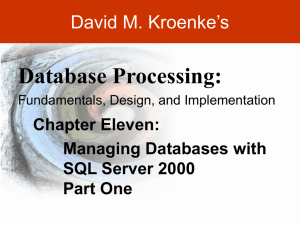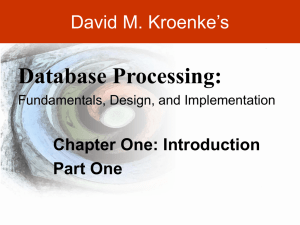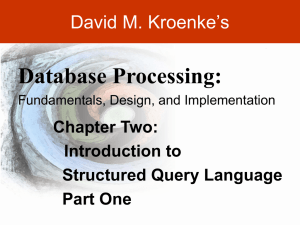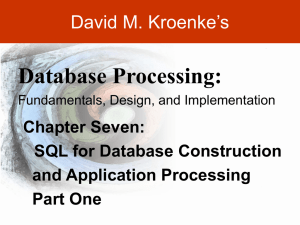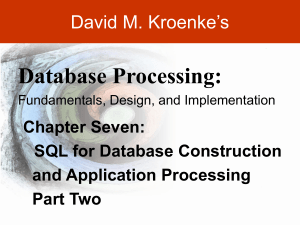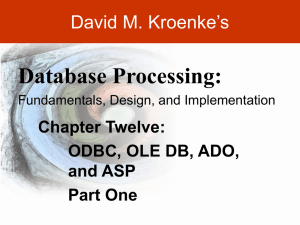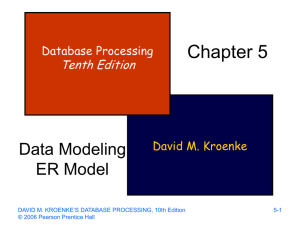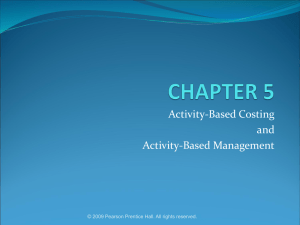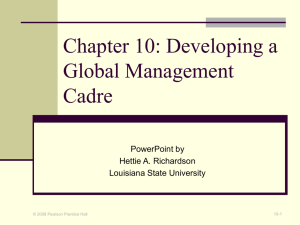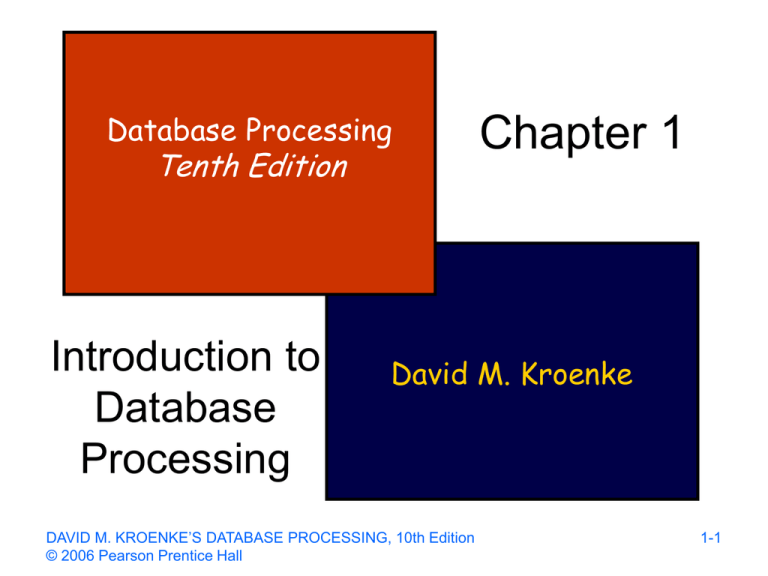
Database Processing
Tenth Edition
Introduction to
Database
Processing
Chapter 1
David M. Kroenke
DAVID M. KROENKE’S DATABASE PROCESSING, 10th Edition
© 2006 Pearson Prentice Hall
1-1
The Characteristics of Databases
• The purpose of a database is to help people
track things of interest to them
• Data is stored in tables, which have rows and
columns like a spreadsheet. A database may
have multiple tables, where each table stores
data about a different thing
• Each row in a table stores data about an
occurrence or instance of the thing of interest
• A database stores data and relationships
DAVID M. KROENKE’S DATABASE PROCESSING, 10th Edition
© 2006 Pearson Prentice Hall
1-2
Data in Tables
DAVID M. KROENKE’S DATABASE PROCESSING, 10th Edition
© 2006 Pearson Prentice Hall
1-3
The Key Characteristic of
Databases: Related Tables
DAVID M. KROENKE’S DATABASE PROCESSING, 10th Edition
© 2006 Pearson Prentice Hall
1-4
Naming Conventions in this Textbook
• Table Names are written with all capital
letters:
– STUDENT, CLASS, GRADE
• Column names are written with an initial
capital letter, and compound names are
written with a capital letter on each word:
– Term, Section, ClassNumber, StudentName
DAVID M. KROENKE’S DATABASE PROCESSING, 10th Edition
© 2006 Pearson Prentice Hall
1-5
Databases Create Information
• Data = Recorded facts and figures
• Information = data presented in a
meaningful context
• Databases record data, but they do so in
such a way that we can produce
information from the data
– The data on STUDENTs, CLASSes and
GRADEs could produce information about
each student’s GPA
DAVID M. KROENKE’S DATABASE PROCESSING, 10th Edition
© 2006 Pearson Prentice Hall
1-6
Database Examples
DAVID M. KROENKE’S DATABASE PROCESSING, 10th Edition
© 2006 Pearson Prentice Hall
1-7
In the Beginning, There Were FileProcessing Systems
• The first business information systems
stored information by grouping similar
data into separate files.
DAVID M. KROENKE’S DATABASE PROCESSING, 10th Edition
© 2006 Pearson Prentice Hall
1-8
A File-Processing System
DAVID M. KROENKE’S DATABASE PROCESSING, 10th Edition
© 2006 Pearson Prentice Hall
1-9
Problems with
File-Processing Systems
•
•
•
•
•
Data separated and isolated
Data often duplicated
Application program dependent
Incompatible data files
Difficult to understand
DAVID M. KROENKE’S DATABASE PROCESSING, 10th Edition
© 2006 Pearson Prentice Hall
1-10
Duplication of Data
• When storing the same data in multiple
locations, the likelihood of inconsistency is
very high.
• What is my real name?
– Table 1: my name is Dan
– Table 2: my name is Danielle
– Table 3: my name is Daniel
– Table 4: my name is Don
DAVID M. KROENKE’S DATABASE PROCESSING, 10th Edition
© 2006 Pearson Prentice Hall
1-11
The Data in a DBMS
•
•
•
•
Data is integrated
Data duplication is reduced
Data is program independent
Data is easy to understand
DAVID M. KROENKE’S DATABASE PROCESSING, 10th Edition
© 2006 Pearson Prentice Hall
1-12
Components of a Database
System: Microsoft Access
DAVID M. KROENKE’S DATABASE PROCESSING, 10th Edition
© 2006 Pearson Prentice Hall
1-13
What Is MS Access?
• MS Access is a DBMS plus an application
generator:
– DBMS creates, processes and administers MS
Access databases
– The application generator includes query, form and
report components
• The MS Access DBMS engine is called Jet,
which is not sold as a separate product
• MS Access 2000 and later can be used as an
application generator for the MS SQL Server
DBMS
DAVID M. KROENKE’S DATABASE PROCESSING, 10th Edition
© 2006 Pearson Prentice Hall
1-14
Microsoft Access
• Microsoft Access is a low-end product intended
for individual users and small workgroups
• MS Access tries to hide much of the underlying
database technology from the user
• A good strategy for beginners, but not for
database professionals
• NOTE: MS Access is discussed in detail in
Appendix A
DAVID M. KROENKE’S DATABASE PROCESSING, 10th Edition
© 2006 Pearson Prentice Hall
1-15
MS Access in Detail
DAVID M. KROENKE’S DATABASE PROCESSING, 10th Edition
© 2006 Pearson Prentice Hall
1-16
Applications, the DBMS and SQL
• Applications are the computer programs
that users work with
• The Database Management System
(DBMS) creates, processes and
administers databases
• Structured Query Language (SQL) is an
internationally recognized standard
database language that is used by all
commercial DBMSs
DAVID M. KROENKE’S DATABASE PROCESSING, 10th Edition
© 2006 Pearson Prentice Hall
1-17
Enterprise-Class Database
Systems
DAVID M. KROENKE’S DATABASE PROCESSING, 10th Edition
© 2006 Pearson Prentice Hall
1-18
Prominent DBMS Products
• Microsoft Access
• Microsoft SQL Server
– New: Microsoft SQL Server Express
• IBM DB2
• Oracle Corporation ORACLE
• And don’t overlook MySQL
DAVID M. KROENKE’S DATABASE PROCESSING, 10th Edition
© 2006 Pearson Prentice Hall
1-19
DBMS Power vs. Ease of Use
DAVID M. KROENKE’S DATABASE PROCESSING, 10th Edition
© 2006 Pearson Prentice Hall
1-20
The Database
• A database is a self-describing collection
of integrated tables
• The tables are called integrated because
they store data about the relationships
between the rows of data
• A database is called self-describing
because it stores a description of itself
• The self-describing data are called
metadata, which is data about data
DAVID M. KROENKE’S DATABASE PROCESSING, 10th Edition
© 2006 Pearson Prentice Hall
1-21
A Database System
DAVID M. KROENKE’S DATABASE PROCESSING, 10th Edition
© 2006 Pearson Prentice Hall
1-22
The Hierarchy of Data
FileProcessing
DBMS
DAVID M. KROENKE’S DATABASE PROCESSING, 10th Edition
© 2006 Pearson Prentice Hall
1-23
Typical Metadata Tables
DAVID M. KROENKE’S DATABASE PROCESSING, 10th Edition
© 2006 Pearson Prentice Hall
1-24
Three Types of Database Design
DAVID M. KROENKE’S DATABASE PROCESSING, 10th Edition
© 2006 Pearson Prentice Hall
1-25
Database Design from Existing Data
DAVID M. KROENKE’S DATABASE PROCESSING, 10th Edition
© 2006 Pearson Prentice Hall
1-26
Data Import: One or Two Tables?
This is an important
decision, and based
on a set of rules
known as
normalization (which
is covered in Chapter
Three)
DAVID M. KROENKE’S DATABASE PROCESSING, 10th Edition
© 2006 Pearson Prentice Hall
1-27
Database Design from New
Systems Development
Entity-Relationship data modeling is covered in Chapter Five, and data model
transformations to database designs are covered in Chapter Six
DAVID M. KROENKE’S DATABASE PROCESSING, 10th Edition
© 2006 Pearson Prentice Hall
1-28
Database Design from Database
Redesign
Database redesign is
covered in Chapter
Eight, after coverage of
SQL in Chapter Seven
DAVID M. KROENKE’S DATABASE PROCESSING, 10th Edition
© 2006 Pearson Prentice Hall
1-29
Database Working Domains
DAVID M. KROENKE’S DATABASE PROCESSING, 10th Edition
© 2006 Pearson Prentice Hall
1-30
A Brief History of
Database
Processing
DAVID M. KROENKE’S DATABASE PROCESSING, 10th Edition
© 2006 Pearson Prentice Hall
1-31
The Relational Database Model
• The dominant database model is the
relational database model – all current
major DBMS products are based on it
• Created by IBM engineer E. F. Codd in
1970
• It was based on mathematics called
relational algebra
• This text examines and explains the
relational database model
DAVID M. KROENKE’S DATABASE PROCESSING, 10th Edition
© 2006 Pearson Prentice Hall
1-32

